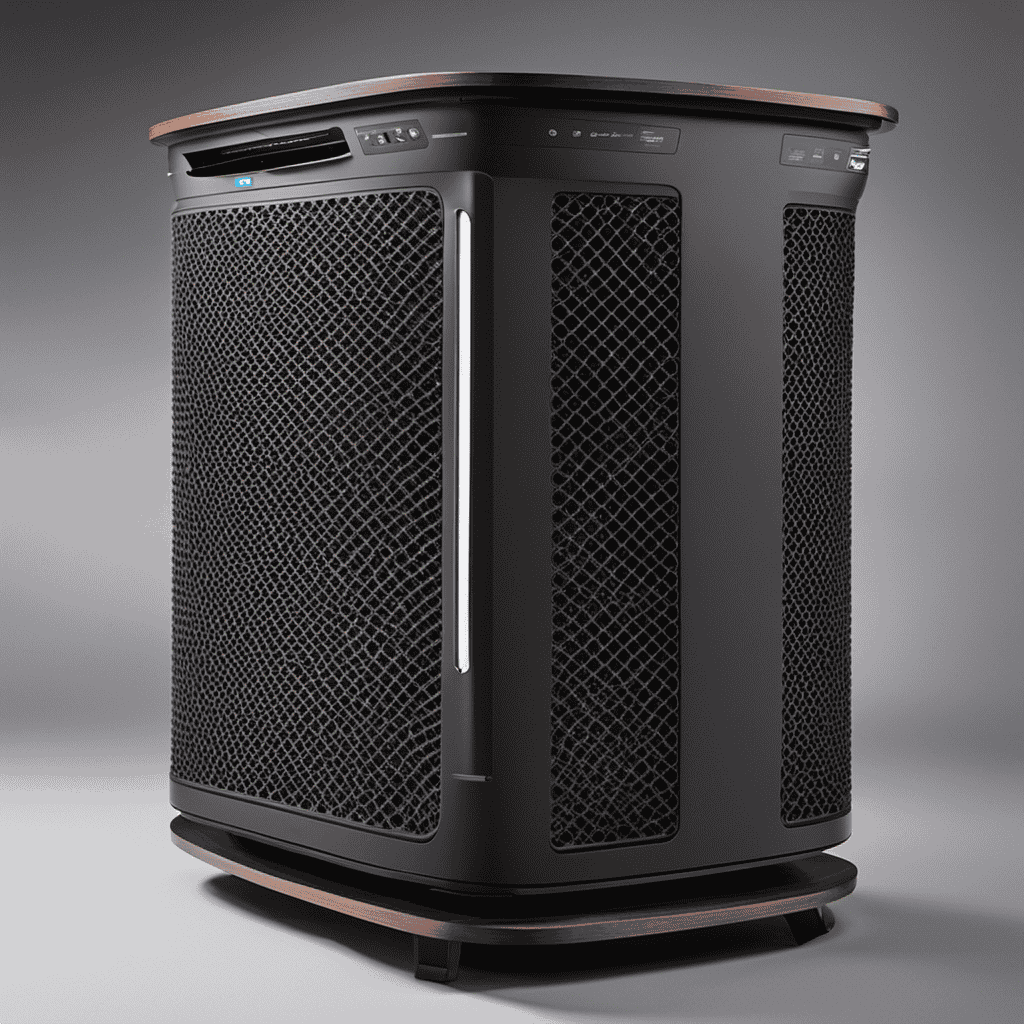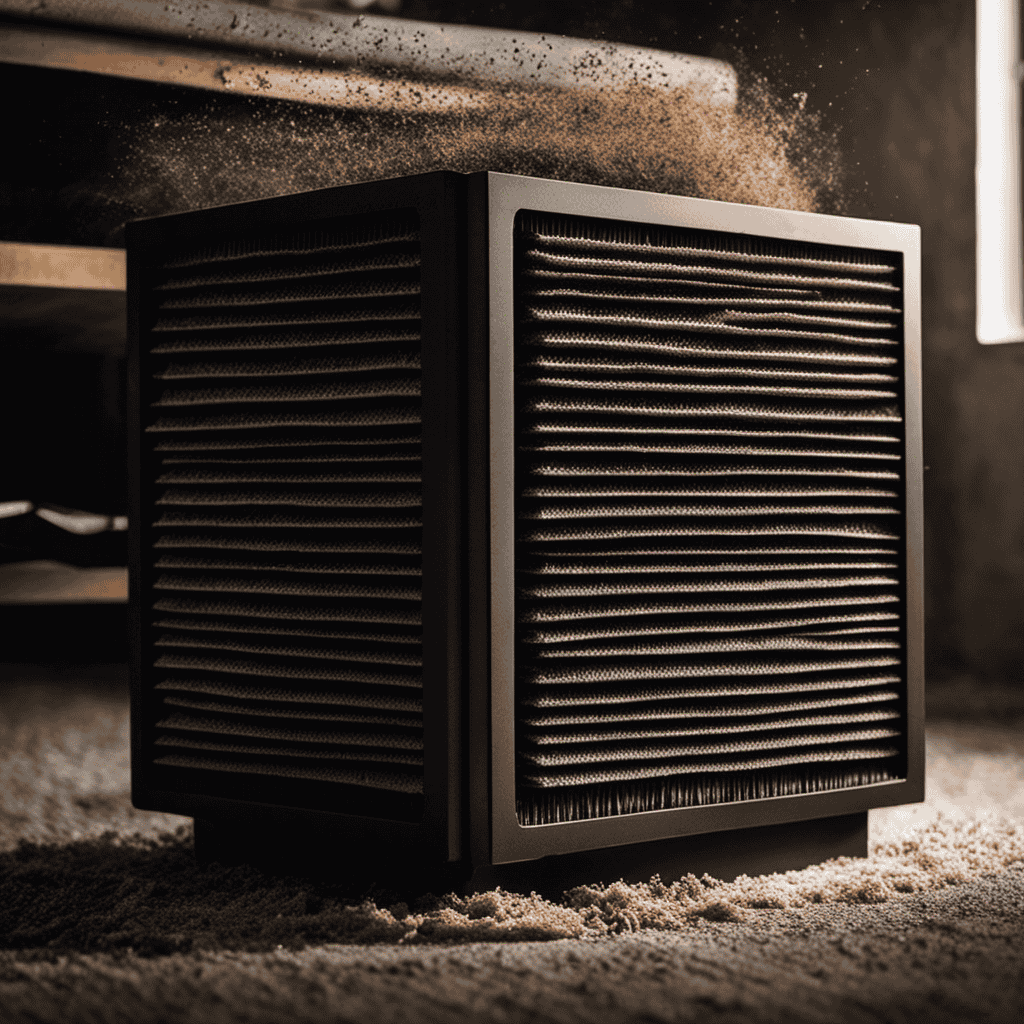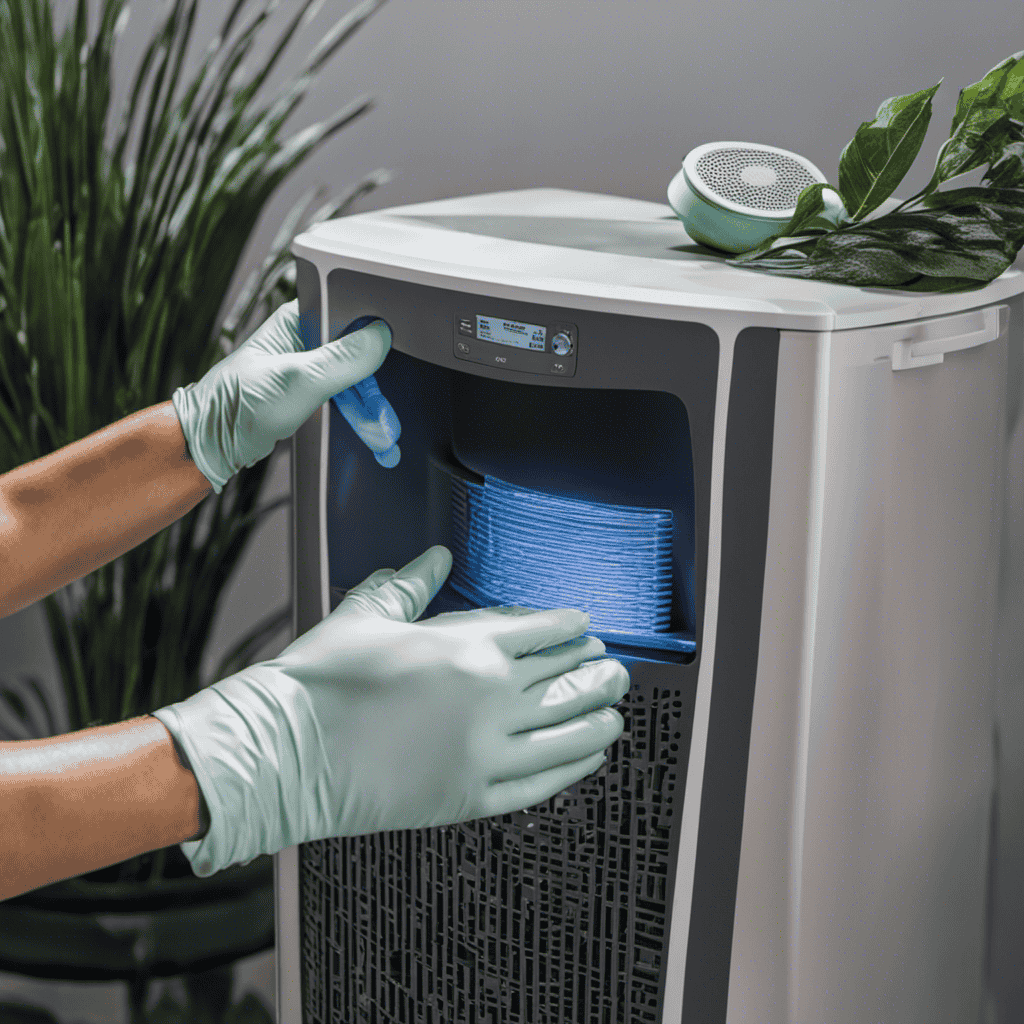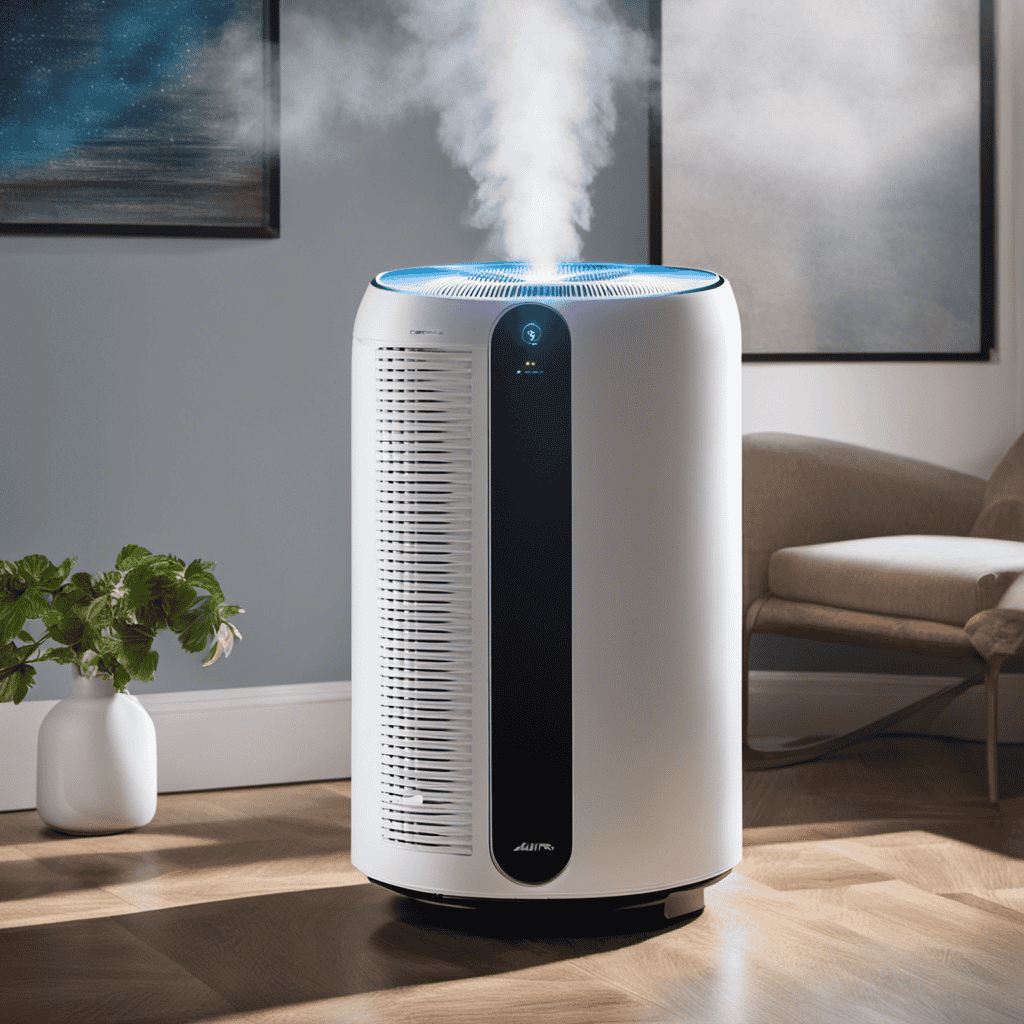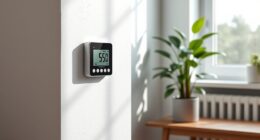I have always been curious about the invisible particles that surround us, and I often wonder how air purifiers operate.
It’s like having a tiny superhero battling the villains of air pollution in your home. With various types of filters and advanced technologies like UV-C light and activated carbon, air purifiers are designed to remove common pollutants, providing cleaner and healthier air.
In this article, we will explore the fascinating world of air purifiers and unravel the science behind their superhero-like abilities.
Key Takeaways
- Air purifiers work by using different types of filters to trap and remove airborne particles, such as dust, pollen, and pet dander.
- HEPA filters, which are made up of densely packed fibers, are highly efficient at capturing small particles and improving indoor air quality.
- UV-C light technology provides an extra layer of protection by killing bacteria, viruses, and microorganisms in the air.
- Activated carbon filters are effective at eliminating odors through a chemical absorption process, providing a convenient and reliable solution for maintaining fresh indoor air.
Types of Air Purifiers
There are two main types of air purifiers that you can choose from: mechanical filters and electronic air cleaners.
Mechanical filters work by physically trapping airborne particles as the air passes through the filter. This type of air purifier is effective in removing larger particles such as dust, pollen, and pet dander.
On the other hand, electronic air cleaners use an electrical charge to attract and capture smaller particles like smoke, bacteria, and viruses. These devices typically have additional features such as activated carbon filters to remove odors and UV-C lights to kill germs.
Popular air purifier brands include Dyson, Honeywell, and Blueair, offering a range of models with different features and coverage capacities to suit various needs and room sizes.
Air Purifier Filters
Filters in air purifiers trap and remove particles like dust, pollen, and pet dander from the air. These filters play a crucial role in improving indoor air quality and ensuring the effectiveness of air purifiers. There are different types of filters used in air purifiers, each with its own technology and capabilities. To understand the effectiveness of air purifiers, it is important to know the different types of filters and their filtration efficiency. Here is a table showing the common types of air purifier filters and their capabilities:
| Filter Type | Technology Used |
|---|---|
| HEPA Filter | High-Efficiency Particulate Air |
| Activated Carbon Filter | Adsorption |
| UV-C Filter | Ultraviolet Germicidal Irradiation |
The Role of HEPA Filters
HEPA filters are highly efficient at trapping and removing particles as small as 0.3 microns from the air. These filters play a crucial role in the effectiveness of air purifiers.
The efficiency of a HEPA filter refers to its ability to capture and retain airborne particles, including dust, pollen, pet dander, and even some bacteria and viruses. HEPA filters are made up of densely packed fibers that create a maze-like structure, allowing them to effectively capture particles through a process called diffusion and interception.
The high efficiency of HEPA filters ensures that the air purifier can effectively remove these harmful particles, improving indoor air quality. Therefore, when considering an air purifier, it is essential to check for HEPA filter efficiency to ensure its effectiveness in providing cleaner and healthier air.
UV-C Light Technology
To effectively eliminate harmful pathogens, you can consider using UV-C light technology in addition to HEPA filters. UV-C light disinfection is a powerful tool that can kill bacteria, viruses, and other microorganisms in the air. It works by emitting ultraviolet light with a wavelength of 253.7 nanometers, which damages the DNA and RNA of these pathogens, preventing them from replicating and causing harm.
When used in air purifiers, UV-C light can provide an extra layer of protection against airborne contaminants. However, it is important to ensure UV-C light safety by following manufacturer instructions and avoiding direct exposure to the eyes and skin.
Here are some benefits of using UV-C light technology in air purifiers:
- Enhanced disinfection capabilities
- Increased efficiency in eliminating harmful pathogens
- Provides an additional layer of protection against airborne contaminants
Activated Carbon Filters
When it comes to odor elimination, activated carbon filters have proven to be highly effective. The chemical absorption process of these filters allows them to trap and remove a wide range of odorous compounds from the air.
In terms of longevity and maintenance, activated carbon filters typically have a lifespan of several months before they need to be replaced, making them a convenient and reliable solution for maintaining fresh and clean indoor air.
Odor Elimination Effectiveness
You’ll be pleased to know that air purifiers are highly effective at eliminating odors in your home. Air purifier technology has advanced significantly in recent years, allowing these devices to effectively target and remove unwanted smells from the air.
Here are three reasons why air purifiers are so effective at odor elimination:
-
Activated Carbon Filters: These filters are designed to trap and absorb odorous particles, such as smoke, pet dander, and cooking smells. The activated carbon has a large surface area that helps to adsorb and neutralize odors.
-
HEPA Filtration: High-Efficiency Particulate Air (HEPA) filters can capture tiny particles as small as 0.3 microns, including odor-causing molecules. By removing these particles from the air, HEPA filters help to reduce and eliminate unpleasant odors.
-
Ozone Generation: Some air purifiers use ozone generation technology to neutralize odors. Ozone molecules can break down and eliminate odor molecules, leaving the air smelling fresh and clean.
In conclusion, air purifiers are highly effective at eliminating odors in your home due to the combination of activated carbon filters, HEPA filtration, and ozone generation.
Now, let’s delve into the chemical absorption process used by activated carbon filters.
Chemical Absorption Process
In the previous subtopic, we discussed the effectiveness of air purifiers in eliminating odors. Now, let’s delve into the chemical absorption process, which is one of the key air purification techniques employed by these devices.
Chemical absorption involves the use of specific materials, such as activated carbon or zeolite, which have a high affinity for certain gases and volatile organic compounds (VOCs) present in the air. These materials contain numerous microscopic pores that can trap and retain these harmful substances. As air passes through the purifier, the pollutants are adsorbed onto the surface of the absorbent material, effectively removing them from the air.
The chemical absorption process is highly effective in capturing a wide range of pollutants, including smoke, chemicals, and odorous compounds. It is a crucial component of air purifiers, ensuring cleaner and healthier air in our indoor environments.
Longevity and Maintenance
To ensure the longevity and optimal performance of your device, regularly clean and replace the absorbent materials in your air purifier. Neglecting maintenance can lead to reduced effectiveness and a shorter lifespan for your air purifier.
Here is a cleaning schedule to help you keep your device in top condition:
- Clean or replace the pre-filter every 3 months to remove large particles like dust and pet hair.
- Clean or replace the activated carbon filter every 6 months to eliminate odors and harmful gases.
- Clean or replace the HEPA filter every 12 months to remove small particles like pollen and allergens.
Following this cleaning schedule will not only improve the air quality in your home but also extend the lifespan of your air purifier.
Ionizers and Ozone Generators
Ionizers and ozone generators can be used in air purifiers to help remove pollutants from the air. Ionizers work by releasing negative ions into the air, which attach to positively charged particles like dust, pollen, and smoke, causing them to become heavy and fall to the ground. This can improve indoor air quality by reducing the number of airborne particles.
On the other hand, ozone generators produce ozone, a molecule that can react with pollutants and neutralize them. However, there are health concerns associated with both ionizers and ozone generators. Ionizers can produce ozone as a byproduct, which at high levels can irritate the respiratory system. Ozone generators, when used improperly or in high concentrations, can also pose health risks.
As a result, it is important to use these technologies with caution and follow manufacturer guidelines.
Transitioning into the subsequent section about electrostatic precipitators, another type of air purifier technology that can effectively remove contaminants from the air.
Electrostatic Precipitators
Electrostatic precipitators, also known as ESPs, use an electrical charge to trap and remove pollutants from the air. These devices have been widely used in industrial settings to improve air quality.
When it comes to efficiency and effectiveness, electrostatic precipitators are highly efficient in removing both large and small particles, including smoke, dust, and pollen. They work by charging the particles and then attracting them to collection plates, where they can be easily cleaned. This makes them a great option for reducing indoor air pollution.
However, it’s important to consider the environmental impact of electrostatic precipitators. They consume a significant amount of energy and produce ozone as a byproduct, which can be harmful to human health.
Transitioning into the next section about air purifier placement, it’s crucial to consider these factors when deciding where to position your device.
Air Purifier Placement
When it comes to air purifier placement, finding the ideal location is crucial for optimal performance.
There are common mistakes that people often make, which can hinder the effectiveness of the air purifier.
In this discussion, I will explore the ideal placement for air purifiers and highlight the common mistakes to avoid, ensuring the best possible air purification results.
Ideal Placement for Air Purifier
To maximize the effectiveness of your air purifier, make sure you place it in an area with good air circulation. This ensures that the purifier can efficiently filter and clean the air in your space.
When it comes to placement, two factors to consider are ceiling placement and air purifier size.
-
Ceiling placement: Mounting the air purifier on the ceiling allows for better distribution of clean air throughout the room. Since air tends to rise, placing the purifier higher up can help capture and filter the contaminants more effectively.
-
Air purifier size: The size of your air purifier should be proportional to the room size. A larger purifier is required for bigger spaces, while smaller purifiers work well in smaller rooms. Choosing the right size ensures that the purifier can adequately clean the air in your specific area.
Common Mistakes in Placement
When it comes to proper positioning of an air purifier, there are some common mistakes that people often make.
One mistake is placing the air purifier in a corner or against a wall. This restricts the airflow and reduces its effectiveness in providing clean air throughout the room.
Another mistake is placing the air purifier too far away from the source of pollution, such as near a window instead of near a pet’s bed. This can result in ineffective coverage and lower air quality.
It is important to place the air purifier in a central location, away from obstructions, and at an appropriate height.
By avoiding these common mistakes, you can ensure that your air purifier is positioned correctly and provides effective coverage for your indoor environment.
Now, let’s move on to the next section about air purifier noise levels.
Air Purifier Noise Levels
If you’re concerned about noise levels, an air purifier can be a great addition to your home. Air purifiers are designed to reduce the amount of pollutants in the air, providing cleaner and healthier indoor air. However, it’s important to consider the noise levels of air purifiers, as excessive noise can impact their effectiveness.
Here are some key points to consider regarding air purifier noise reduction and its impact on effectiveness:
- Noise levels vary among different air purifier models. Some models are designed to operate quietly, while others may produce more noise.
- High noise levels can be distracting, especially in bedrooms or offices where quiet is essential.
- Excessive noise can also interfere with sleep and concentration, impairing overall well-being.
To ensure optimal effectiveness and a peaceful environment, it is important to choose an air purifier that offers noise reduction features and operates at a comfortable noise level for your specific needs.
Air Purifier Maintenance
When it comes to air purifier maintenance, there are a few key tips to keep in mind.
First and foremost, it’s important to clean your air purifier regularly. This involves removing the filter and giving it a thorough cleaning according to the manufacturer’s instructions.
Additionally, you should also clean the exterior of the air purifier to remove any dust or debris that may have accumulated.
It’s also a good idea to check the air purifier’s fan and motor for any signs of wear or damage.
By following these maintenance tips, you can ensure that your air purifier continues to function effectively and efficiently.
Transitioning to the subsequent section on the benefits of using an air purifier, let’s explore how having a well-maintained air purifier can improve the quality of the air we breathe.
Benefits of Using an Air Purifier
To improve the quality of the air you breathe, consider the benefits of using a well-maintained air purifier. Air purifiers play a crucial role in enhancing sleep quality and promoting respiratory health. Here are some key benefits:
-
Reduces allergens: Air purifiers effectively filter out pollen, pet dander, and other common allergens, helping to alleviate symptoms such as sneezing, congestion, and itching.
-
Removes airborne pollutants: Air purifiers eliminate harmful pollutants like dust, smoke particles, and volatile organic compounds (VOCs) that can cause respiratory irritation and long-term health issues.
-
Improves sleep quality: By removing airborne particles and pollutants, air purifiers create a cleaner and healthier sleeping environment, allowing for better quality sleep and reducing the risk of sleep-related respiratory problems.
Incorporating an air purifier into your home or bedroom can have significant positive effects on both your sleep quality and respiratory health.
Common Air Pollutants Removed by Air Purifiers
You’ll be surprised by the wide range of common air pollutants that can be effectively removed by using an air purifier. Air purifiers are highly effective in improving indoor air quality by eliminating harmful particles and pollutants. Here is a table showcasing the effectiveness of air purifiers in removing various common air pollutants:
| Air Pollutant | Effectiveness of Air Purifiers |
|---|---|
| Dust and Allergens | High |
| Pollen | High |
| Pet Dander | High |
| Mold Spores | High |
Air purifiers work by using filters to capture and trap these pollutants, preventing them from circulating in the air. This not only improves the air quality but also reduces the risk of respiratory issues and allergies. Investing in an air purifier can have a significant impact on creating a healthier and cleaner indoor environment.
Air Purifiers for Allergies
When it comes to allergies, air purifiers can be a game-changer. Not only do they help remove common allergens like pollen and dust mites, but they can also target specific allergens like pet hair and mold spores.
Air purifiers for pet hair use specialized filters to capture and trap pet dander and hair, reducing the allergens in the air. This can be especially beneficial for individuals who suffer from pet allergies and want to create a more comfortable living environment.
Similarly, air purifiers for mold spores employ filters designed to capture and eliminate mold spores from the air. This can be crucial for individuals with mold allergies or those who live in damp environments where mold growth is common.
Air Purifiers for Asthma
When it comes to finding relief from asthma symptoms, air purifiers can be a valuable tool.
The benefits of air purifiers for asthma sufferers are numerous, as they can help remove airborne triggers such as dust mites, pollen, and pet dander.
However, choosing the right asthma-friendly purifier is crucial to ensuring its effectiveness in improving indoor air quality and reducing asthma attacks.
Asthma Relief With Purifiers
Using an air purifier can provide relief for your asthma symptoms. Air purifiers are designed to filter out pollutants and allergens from the air, which can significantly improve the quality of the air you breathe. This can have a positive impact on both your sleep quality and respiratory health.
Air purifiers remove airborne irritants such as dust mites, pollen, and pet dander, reducing the triggers that can worsen asthma symptoms. By eliminating these irritants, air purifiers can help you breathe easier, reducing the frequency and severity of asthma attacks.
Improved air quality can also promote better sleep, as it reduces congestion and inflammation in the airways, allowing for more restful nights.
Benefits of Air Purifiers
By filtering out pollutants and allergens, air purifiers can greatly improve the quality of the air you breathe, providing significant benefits for your respiratory health. This is especially important for individuals who smoke or live with smokers, as tobacco smoke contains harmful chemicals that can damage the lungs and worsen respiratory conditions. Air purifiers designed specifically for smokers are equipped with advanced filtration systems that effectively remove smoke particles and odor from the air, creating a healthier indoor environment. Additionally, air purifiers are also beneficial for small spaces, such as apartments or offices, where air circulation may be limited. These compact purifiers are designed to effectively clean the air in confined areas, ensuring that you are breathing in clean and fresh air, regardless of the size of your living or working space.
| Benefits of Air Purifiers | |
|---|---|
| Improved air quality | Reduces allergies |
| Removes pollutants | Eliminates odors |
Choosing Asthma-Friendly Purifiers
When it comes to managing asthma, avoiding triggers is crucial. One effective way to reduce asthma triggers is by improving indoor air quality. Air purifiers can play a significant role in achieving this goal.
Here are three reasons why choosing asthma-friendly purifiers is essential:
-
Filtration efficiency: Asthma-friendly purifiers are equipped with high-efficiency particulate air (HEPA) filters, which can trap tiny particles such as pollen, dust mites, and pet dander.
-
Reduced allergens: By removing common allergens from the air, asthma-friendly purifiers can help minimize asthma symptoms and improve overall respiratory health.
-
Cleaner air: Purifiers with activated carbon filters can help eliminate volatile organic compounds (VOCs), odors, and other irritants, providing cleaner and fresher air for individuals with asthma.
By selecting an asthma-friendly air purifier, you can create a healthier environment and reduce the risk of asthma attacks.
Now, let’s explore how air purifiers can benefit pet owners in the next section.
Air Purifiers for Pet Owners
If you’re a pet owner, an air purifier can help you control pet dander and allergens in your home. Pet dander is a common allergen that can cause respiratory issues and allergies in sensitive individuals. An air purifier works by capturing and trapping these particles, preventing them from circulating in the air. Additionally, some air purifiers are equipped with activated carbon filters that can help reduce pet odors. These filters absorb and neutralize the odor molecules, leaving your home smelling fresh and clean. Here is a table that compares different air purifiers for pet owners:
| Air Purifier | Key Features | Coverage Area |
|---|---|---|
| Model A | HEPA Filter | 500 sq. ft. |
| Model B | Carbon Filter | 800 sq. ft. |
| Model C | UV-C Light | 1000 sq. ft. |
Frequently Asked Questions
Can Air Purifiers Completely Eliminate All Allergens in a Room?
Air purifiers can effectively reduce allergens in a room, but they may not completely eliminate them. While they can capture and remove particles, some allergens like pollen may still enter through open windows or on clothing.
How Long Do Air Purifier Filters Typically Last Before They Need to Be Replaced?
Air purifier filters typically last for several months before needing replacement. Regular air purifier maintenance is important to ensure optimal performance. Signs of a dirty air filter include reduced airflow and increased allergens in the room.
Are There Any Health Risks Associated With Using UV-C Light Technology in Air Purifiers?
There are no known health risks associated with using UV-C light technology in air purifiers. UV-C light is effective in killing germs and bacteria, providing health benefits by improving indoor air quality.
Do Activated Carbon Filters Remove Unpleasant Odors From the Air?
Activated carbon filters are great at removing unpleasant odors from the air. They work by trapping and absorbing odor-causing particles. When choosing an air purifier, consider the combination of activated carbon and HEPA filters for best results.
Are Ionizers and Ozone Generators Safe to Use Around Pets and Children?
Ionizers and ozone generators have pros and cons. While they can help remove airborne particles, they also release ozone, which can be harmful to pets and children. Air purifiers can effectively reduce pet and child allergies.
Conclusion
In conclusion, air purifiers are an essential tool in maintaining clean and healthy indoor air. They come in various types, each with its own set of benefits.
HEPA filters effectively trap allergens and pollutants, while UV-C light technology destroys harmful bacteria and viruses. Activated carbon filters eliminate odors and chemicals.
By removing common air pollutants, air purifiers provide relief for allergies, asthma, and pet owners. So, whether you’re looking to improve your indoor air quality or combat specific issues, air purifiers are a reliable and effective solution.
